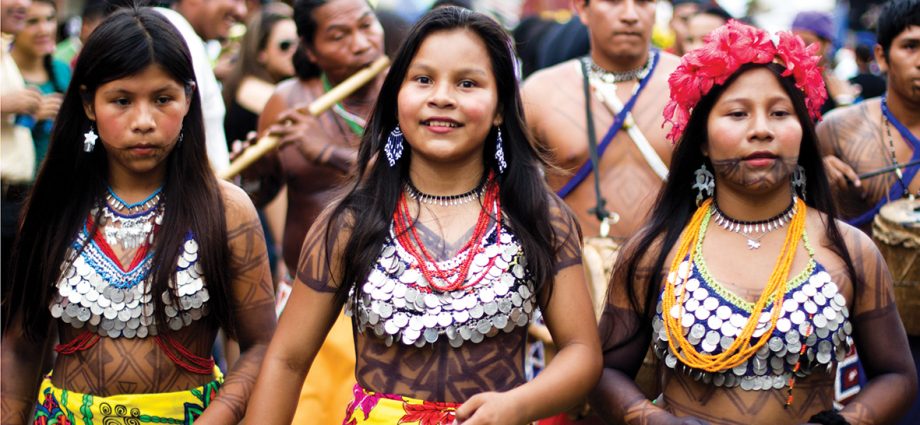Isabela Sekeff, Music therapist and choral conductor, Brazil
Choral singing is present in many ethnic groups and cultures around the world, regardless of the historical period, style, or function for which it is intended. Its practice appears from antiquity to the present day, ranging from collective singing for religious celebrations, to festive and work rituals, to groups of elaborate artistic performance. Despite its often spontaneous and intuitive manifestation, wherever it occurs choral singing becomes the materialization of one of the most efficient instruments of memory, maintenance, and the dissemination of roots, and also of social, cultural, and artistic traditions.
In the history of Western music, it is possible to identify clearly how the use of choral music presents the main characteristics and practices related to each artistic period. In ancient Greece we had the choros: groups of singers and dancers who wore masks and performed monophonic songs. These singers interpreted important parts of Greek drama, which, in turn, evolved from religious ceremonies. Jewish culture, another pre-Christian culture, has records of a structured choral practice accompanied by instruments, performed in both religious and festive ceremonies. Plainchant, the main musical reference of the Middle Ages, gives us a better understanding and perception of medieval man through its characteristic melodies and its free rhythm linked to the text. In the Renaissance, we see the beginning of different perspectives, through polyphony and its various layers, and we also see choral singing begin to be used in its secular manifestation through madrigals, chansons, and other secular musical forms. Vocal forms multiplied all around, giving rise to operas, cantatas, oratorios, choral song cycles, part-songs and so many different forms. In each period of history, we have a living example of how choral singing both reflected and revealed societal values, patterns, and thoughts of the time.
However, it is not just within the broad lines of the history of Western music that choral singing becomes a reference for the context and understanding of human beings and their social, cultural, and human relationships. The practice of choral singing is deeply rooted within small cultures, in popular manifestations, in the infinite stories that are not fully told and in the realities that have not become generalized. It is the memory of popular songs, disseminated in various social activities, which carry relationships with life, ways of loving and living, the different faces of a society. There are folk songs which keep alive the fantastic legends and the collective imagination. There are work songs, celebratory songs, and ritualistic songs which put us in touch with the undercurrents of its culture and society. And it is through these artistic practices that different traditions are perpetuated, not only artistic and musical traditions, but also ethno-musicological, linguistic and historic traditions.
From the ethno-musicological point of view, choral singing is fundamental for understanding the traditions of a people: their identifying elements are organized, transmitted, and maintained through festivities and rites. Such elements include the meaning of the text, stories that are told, and historical records. Further, body performance characteristics such as dances, costumes, and even scenery are items that are internalized in each culture’s choral performances. It is necessary to abstract the concept of purely artistic performance in order to understand in depth the ethno-musicological value of this practice. The quality or technique of the performance is not in question here, but rather the traditions and customs that are perpetuated. It is the living culture present in that manifestation.
The linguistic issue is also a point to be analyzed in the maintenance of roots and traditions through choral singing. Since it is a sung practice, there is necessarily a record of its original languages. As a result, the practice of choral singing becomes valuable in the dissemination of different languages, regional dialects, and minority languages. In addition to the written record of the language, the choir can also offer the sound reference of the language, its pronunciation and accent.
In Brazil, we have many examples of how the practice of choral singing can be an instrument for the conservation and dissemination of these roots and traditions. Composer Waldemar Henrique, born in northern Brazil in 1905, dedicated a large part of his work to themes linked to his native region: the Amazon. Among his works, there is a series of eleven songs called Lendas Amazônicas, which narrate the fantastic and imaginary folkloric figures that inhabit the forests in this region of the country. In 2016, André Vidal, a Brazilian composer and arranger, arranged nine of these songs for chorus. Folk themes such as these, which are often disseminated through oral tradition, became permanently recorded through this work.
Another practical example takes us to the research work of the singer and composer Renata Mattar. Renata, born in the city of São Paulo (1969), collects and records work songs in Brazil. These are centuries-old songs from rural communities in the interior of Brazil, passed down orally from one generation to another, sung with voices and performed during different work practices.
Brazil records, even today, more than two hundred indigenous dialects spoken by different ethnic groups. Several composers wrote works in these original languages that, somehow, are perpetuated and spread through these works. Composer Heitor Villa-Lobos gave us Duas Lendas Ameríndias em Nheengatu, written in this dialect derived from Tupinambá and spoken in the Amazon region. In addition to the marked indigenous influence, Brazil also has a notable record of African culture. There are countless choral songs that are written in Afro-Brazilian dialects and aesthetics.
Just like these examples, each culture preserves numerous records of compositions and arrangements (elaborated or spontaneous) that perpetuate our memories, legends, dances, rituals, poetry, stories, and all those unique and symbolic traditions that make each of us authentic peoples.
There is no doubt that choral singing is a great instrument for maintaining the traditions of a people. As conductors, we must recognize and understand this role. On the one hand we have a cultural universe at our disposal; on the other hand we also have an obligation to value and disseminate our own culture, promoting our roots and strengthening our own identities.
 Isabela Sekeff is a PhD student in music at UNICAMP, Master in Choral Conducting at the University of Missouri, United States, Specialist in Music Therapy at the Brazilian Conservatory of Music in Rio de Janeiro and Licensed in Music Education at the University of Brasília. Sekeff is currently a Substitute Professor at the University of Brasilia in the Chair of Conducting and Musical Structuring since 2021. She worked at the Brasília Music School for thirty years, where she also served as Coordinator and Supervisor Pedagogical. And she was principal conductor of Madrigal de Brasília from 2018 to 2021, a professional choir formed by teachers and students of the Brasília Music School. She is principal conductor of Coral Cantus Firmus, an independent group that she founded in 1992 and which is among the best groups in Brazil. isabelasekeff@gmail.com
Isabela Sekeff is a PhD student in music at UNICAMP, Master in Choral Conducting at the University of Missouri, United States, Specialist in Music Therapy at the Brazilian Conservatory of Music in Rio de Janeiro and Licensed in Music Education at the University of Brasília. Sekeff is currently a Substitute Professor at the University of Brasilia in the Chair of Conducting and Musical Structuring since 2021. She worked at the Brasília Music School for thirty years, where she also served as Coordinator and Supervisor Pedagogical. And she was principal conductor of Madrigal de Brasília from 2018 to 2021, a professional choir formed by teachers and students of the Brasília Music School. She is principal conductor of Coral Cantus Firmus, an independent group that she founded in 1992 and which is among the best groups in Brazil. isabelasekeff@gmail.com
Edited by Gillian Forlivesi Heywood, Italy/UK


